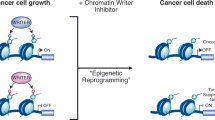Abstract
Structural modules that specifically recognize—or read—methylated or acetylated lysine residues on histone peptides are important components of chromatin-mediated signaling and epigenetic regulation of gene expression. Deregulation of epigenetic mechanisms is associated with disease conditions, and antagonists of acetyl-lysine binding bromodomains are efficacious in animal models of cancer and inflammation, but little is known regarding the druggability of methyl-lysine binding modules. We conducted a systematic structural analysis of readers of methyl marks and derived a predictive druggability landscape of methyl-lysine binding modules. We show that these target classes are generally less druggable than bromodomains, but that some proteins stand as notable exceptions.





Similar content being viewed by others
Explore related subjects
Discover the latest articles and news from researchers in related subjects, suggested using machine learning.References
Grewal SI, Moazed D (2003) Heterochromatin and epigenetic control of gene expression. Science 301:798–802
Jenuwein T, Allis CD (2001) Translating the histone code. Science 293:1074–1080
Strahl BD, Allis CD (2000) The language of covalent histone modifications. Nature 403:41–45
Kelly TK, De Carvalho DD, Jones PA (2010) Epigenetic modifications as therapeutic targets. Nat Biotechnol 28:1069–1078
Portela A, Esteller M (2010) Epigenetic modifications and human disease. Nat Biotechnol 28:1057–1068
Prince HM, Bishton MJ, Harrison SJ (2009) Clinical studies of histone deacetylase inhibitors. Clin Cancer Res 15:3958–3969
Daigle SR et al (2011) Selective killing of mixed lineage leukemia cells by a potent small-molecule DOT1L inhibitor. Cancer Cell 20:53–65
Vedadi M et al (2011) A chemical probe selectively inhibits G9a and GLP methyltransferase activity in cells. Nat Chem Biol 7:566–574
Ruthenburg AJ, Li H, Patel DJ, Allis CD (2007) Multivalent engagement of chromatin modifications by linked binding modules. Natl Rev Mol Cell Biol 8:983–994
Taverna SD, Li H, Ruthenburg AJ, Allis CD, Patel DJ (2007) How chromatin-binding modules interpret histone modifications: lessons from professional pocket pickers. Nat Struct Mol Biol 14:1025–1040
Vermeulen M et al (2010) Quantitative interaction proteomics and genome-wide profiling of epigenetic histone marks and their readers. Cell 142:967–980
Sanchez R, Zhou MM (2009) The role of human bromodomains in chromatin biology and gene transcription. Curr Opin Drug Discov Devel 12:659–665
Haynes SR et al (1992) The bromodomain: a conserved sequence found in human, Drosophila and yeast proteins. Nucleic Acids Res 20:2603
Musselman CA, Kutateladze TG (2009) PHD fingers: epigenetic effectors and potential drug targets. Mol Interv 9:314–323
Baker LA, Allis CD, Wang GG (2008) PHD fingers in human diseases: disorders arising from misinterpreting epigenetic marks. Mutat Res 647:3–12
Adams-Cioaba MA, Min J (2009) Structure and function of histone methylation binding proteins. Biochem Cell Biol 87:93–105
Kim J et al (2006) Tudor, MBT and chromo domains gauge the degree of lysine methylation. EMBO Rep 7:397–403
Maurer-Stroh S et al (2003) The Tudor domain ‘Royal Family’: Tudor, plant Agenet, Chromo, PWWP and MBT domains. Trends Biochem Sci 28:69–74
Filippakopoulos P et al (2010) Selective inhibition of BET bromodomains. Nature 468:1067–1073
Nicodeme E et al (2010) Suppression of inflammation by a synthetic histone mimic. Nature 468:1119–1123
Herold JM et al (2011) Small-molecule ligands of methyl-lysine binding proteins. J Med Chem 54:2504–2511
Wang M et al (2010) Structural genomics of histone tail recognition. Bioinformatics 26:2629–2630
Yap KL, Zhou MM (2010) Keeping it in the family: diverse histone recognition by conserved structural folds. Crit Rev Biochem Mol Biol 45:488–505
Min J et al (2007) L3MBTL1 recognition of mono- and dimethylated histones. Nat Struct Mol Biol 14:1229–1230
Guo Y et al (2009) Methylation-state-specific recognition of histones by the MBT repeat protein L3MBTL2. Nucleic Acids Res 37:2204–2210
Halgren TA (2009) Identifying and characterizing binding sites and assessing druggability. J Chem Inf Model 49:377–389
Schmidtke P, Souaille C, Estienne F, Baurin N, Kroemer RT (2010) Large-scale comparison of four binding site detection algorithms. J Chem Inf Model 50:2191–2200
Kaustov L et al (2010) Recognition and specificity determinants of the human cbx chromodomains. J Biol Chem 286:521–529
Wang Z et al (2010) Pro isomerization in MLL1 PHD3-bromo cassette connects H3K4me readout to CyP33 and HDAC-mediated repression. Cell 141:1183–1194
Collins RE et al (2008) The ankyrin repeats of G9a and GLP histone methyltransferases are mono- and dimethyllysine binding modules. Nat Struct Mol Biol 15:245–250
Horton JR et al (2010) Enzymatic and structural insights for substrate specificity of a family of jumonji histone lysine demethylases. Nat Struct Mol Biol 17:38–43
Palacios A et al (2008) Molecular basis of histone H3K4me3 recognition by ING4. J Biol Chem 283:15956–15964
Acknowledgments
The Structural Genomics Consortium is a registered charity (number 1097737) that receives funds from Canadian Institutes for Health Research, Canadian Foundation for Innovation, Genome Canada through the Ontario Genomics Institute, GlaxoSmithKline, Eli Lilly, Pfizer, Novartis Research Foundation, Life Technologies, Ontario Innovation Trust, Ontario Ministry for Research and Innovation, and Wellcome Trust.
Author information
Authors and Affiliations
Corresponding author
Electronic supplementary material
Below is the link to the electronic supplementary material.
Rights and permissions
About this article
Cite this article
Santiago, C., Nguyen, K. & Schapira, M. Druggability of methyl-lysine binding sites. J Comput Aided Mol Des 25, 1171–1178 (2011). https://doi.org/10.1007/s10822-011-9505-2
Received:
Accepted:
Published:
Issue Date:
DOI: https://doi.org/10.1007/s10822-011-9505-2




